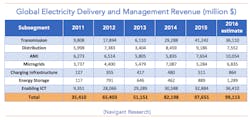Microgrid revenue rose 29 percent from 2015 to 2016, reaching $6.8 billion globally, according to a report issued today by Advanced Energy Economy (AEE).
Prepared by Navigant Research, AEE’s 2017 Market Report also found that Asia Pacific led the microgrid market followed by North America.
In the United States, the microgrid market continued a five-year gallop upward. Microgrid revenue has more than doubled since 2011, reaching $2.2 billion in 2016, a 16 percent year-over-year increase from 2015 to 2016.
Energy storage, a smaller market than microgrids, made a bigger leap year-over-year. Revenue climbed 45 percent, making energy storage a $1.1 billion global market. In the U.S., the energy storage market reached $427 million, a 54 percent rise.
Charging infrastructure for plug-in electric vehicles proved to be another small, but fast growing market, rising 69 percent over 2015 to reach $864 million — a sevenfold increase compared to 2011. In the U.S. the charging market saw a 576 percent increase over five-years, reaching $182 million.
Microgrids and energy storage were the leaders for annual growth in their market segment, what AEE describes as electric delivery and management. The segment, which also includes smart grid, electric vehicle charging, and transmission and distribution, constitutes a $19 billion U.S. market and $99 billion global market.
Overall, however, electric delivery and management saw only anemic growth of three percent in the U.S., dragged down year-over-year by a fall in transmission investment (six percent) and distribution (13 percent.) Still, transmission produces the most revenue in the segment, $6.8 billion, down from $7.2 billion the previous year.
Advanced metering infrastructure also reduced the sector’s growth, with its four-year downward slope of 18 percent since 2012.
Virtual power plant trend bolsters microgrids, energy storage
The report also looks at various trends influencing advanced energy markets, among them virtual power plants, a concept increasingly associated with microgrids and energy storage.
Virtual power plants are intelligent distributed energy resources often dispatched in an aggregated fashion to serve the grid. Microgrids can act as virtual power plants.
AEE says that virtual power plants are becoming more complex and multi-dimensional, mixing generation and demand-reducing resources, and bridging the two with energy storage – typically batteries or flywheels. These more complex configurations are appearing in such places as California, New York, Austria, Australia, and Ontario, according to the report.
The report focuses on a range of other advanced energy technologies, which AEE defines as “technologies, products, and services that constitute the best available technologies for meeting energy needs today and tomorrow.”
In addition to the electricity management and delivery technologies, others include natural gas-fueled trucks, high-performance buildings, energy-saving industrial processes, high capacity wind turbines, on-site and utility scale solar power, and nuclear power plants.
Among them, solar continued its dramatic ascent, adding 72 GW in 2016, an all-time record and 52 percent more than in 2015. The U.S. market for solar reached $24.9 billion in 2016 up from $19.2 billion a year earlier, and $8.2 billion five years earlier.
AEE found that overall advanced energy market grew five percent globally from 2015 to 2016, nearly twice the rate of the world economy.
[clickToTweet tweet=”Advanced #energy grew at nearly 2x the rate of the world economy in 2016″ quote=”Advanced energy grew at nearly 2x the rate of the world economy in 2016″]
In all, advanced energy represents a $1.4 trillion global market and a $200 billion U.S. market, according to the report. To give perspective on what that means, the advanced energy market is nearly twice the size of the airline industry, equal to apparel, and close to global spending on media — from newspapers to movies to video games, according to AEE. In the U.S., advanced energy was nearly twice the size of the beer market by revenue, equal to pharmaceutical manufacturing, and nearly as big as the wholesale market for consumer electronics.
“Over the past six years, the U.S. advanced energy market has grown a stunning 28 percent, with significant economic impact, now supporting more than 3 million jobs across the nation,” said Graham Richard, AEE CEO.
Track news about growth in microgrid revenue by subscribing to the Microgrid Knowledge newsletter. It’s free.







